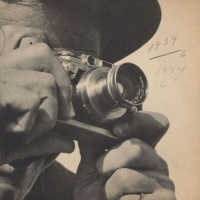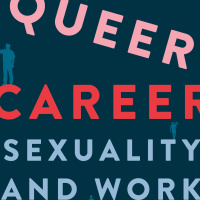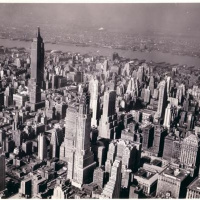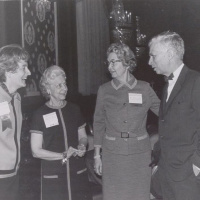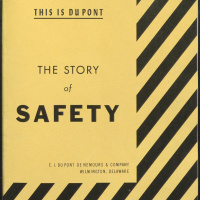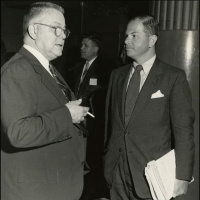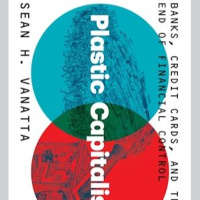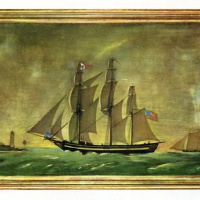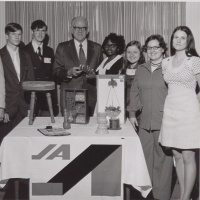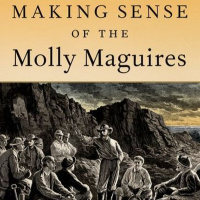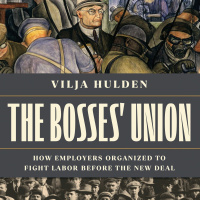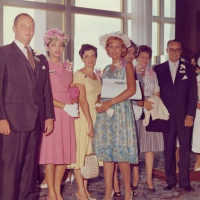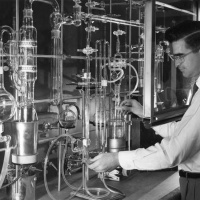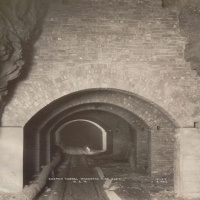Sinopsis
Podcast by Hagley Museum and Library
Episodios
-
Negating Visions: Cultural Memory and Media Negatives with Stefka Hristova
25/11/2024 Duración: 14minThe positive image cannot exist without the negative, and the relationship between the two reveals the fundamental nature of the image as fungible, media as a process, and truth value as a matter of interpretation. Scholarship and conservation therefore have a profound responsibility to collect, preserve, and interpret media negatives for what they reveal about the relationship between positive images and the truth. In her latest project, Dr. Stefka Hristova, associate professor at Michigan Technological University, theorizes the relationship between media negatives, their positive counterparts, and the truth value accessible through a careful study of both. Using the collections held in the Hagley Library, Hristova demonstrates that a photographic image cannot be understood without reference to its negative. Likewise, and with profound implications for our present moment, the images and other media generated algorithmically cannot be properly judged or interpreted without an understanding of their negatives
-
Queer Career: Sexuality and Work in Modern America with Margot Canaday
11/11/2024 Duración: 49minIn this episode of Hagley History Hangout Roger Horowitz interviews Margot Canaday about her remarkable book Queer Career: Sexuality and Work in Modern America that received the received 2024 Hagley Prize for the best book in business history that year. Canaday’s Queer Career’s rincipal focus is on the private sector, business enterprises large and small, and traces the opportunities, obstacles, and accomplishments of LGBT+ people as they sought to make a living from the 1950s through today. She emphasizes that as federal and many state agencies routinely refused to hire LGBT+ people, their most important sources of employment was in the private sector. Still facing pressures to keep their sexuality hidden in their jobs, their precarity lead them to accept lesser positions and pay than they might otherwise would have qualified for. Once stablished, they nonetheless made great strides in economic opportunity over these decades in white collar and blue collar jobs, and by creating their own firms. Her ana
-
New York City’s Urban Heat Island, 1860-2020 with Kara Schlichting
28/10/2024 Duración: 29minExcessive heat has presented a problem for public health officials in New York City since the mid-nineteenth century building boom that covered the island of Manhattan in bricks, concrete, and other heat-storing materials. Prior to that, however, Americans had noticed that cities were warmer than their surrounding countryside as early as the 1790s. The phenomenon now known as the “urban heat island” has shaped the bodily experiences and collective destinies of millions. In her latest research, Dr. Kara Schlichting, associate professor at the City University of New York, uncovers the complex relationship between the evolving built environment of the city, the macro-climatic conditions prevailing globally, and the socially-differentiated lived experiences of heat had by city residents. By digging into Hagley collections, including trade catalogs and the Willis Carrier collection, Schlichting is able to tell a history that links multiple scales of time and space, an act of scholarly imagination that allows us
-
Manufacturing Self-Determination: Industry on Native American Reservations with Sam Schirvar
14/10/2024 Duración: 27minThe political meaning of industry depends upon its context. Following the Second World War, Native American tribal governments engaged in a program of industrial development meant to secure the political self-determination of their nations. Initially concerned with attracting capital investment to reservation communities, by the 1970s native governments had moved on to become investors in wholly owned tribal enterprises. In his dissertation research, Sam Schirvar, PhD candidate at the University of Pennsylvania uncovers a story that is both surprising and revealing of deeper patterns in American history. While outsiders saw industrial development as a means to efface native communities and tribal governments, tribal leaders themselves saw it as a means to self-determination. While the wider American economy was moving toward privatization of enterprise, Native Americans were creating publicly owned industries. Industry can mean different things to different people at different times. In support of his res
-
Back on Track American Railroad Accidents and Safety 1965-2015 with Mark Aldrich
30/09/2024 Duración: 57minBen Spohn interviews Mark Aldrich about his 2018 book, Back on Track American Railroad Accidents and Safety 1965-2015. This period marked a decline in safe operating on American railroads through the 1970s which were followed by a period of increased safety and profitability for American railroads. Aldrich makes the case that the joint factors of economic deregulation through the Staggers Act and the federalization of railroad safety via the Federal Railroad Administration (FRA) drew attention to safety issues on the railroad like poor track condition, unsafe grade crossings, or engineer fatigue and left railroads with not only incentives to become safer, but enough money in their coffers to adequately shore up these safety concerns. Mark Aldrich is the Marilyn Carlson Nelson Professor of Economics emeritus at Smith College. Back on Track American Railroad Accidents and Safety 1965-2015 is a sequel to Aldrich’s earlier book on railroad safety, Death Rode the Rails: American Railroad Accidents and Safety, 18
-
Health, Safety, & Risk Communication at DuPont in the Twentieth Century with Madison Krall
16/09/2024 Duración: 22minThe DuPont firm was a leader in workplace and community safety communications during the twentieth century. This had been baked into the company culture from the first, as gunpowder manufacturing made essential. What changed over time were the techniques and media of communication, and the intended audience targeted by the company’s messaging. In her latest research, Madison Krall, assistant professor of communication studies at Seton Hall University, explores the wealth of health and safety materials generated by the DuPont company during the twentieth century. From posters to motion pictures, the firm deployed a wide array of media to promote safety in the workplace and beyond. DuPont wished to convince the public that its products were safe, and to convince employees and community members that safety was their responsibility. In support of her work Dr. Krall received funding from the Center for the History of Business, Technology, and Society at the Hagley Museum and Library. For more Hagley History Han
-
Forging the Network: International Industrial Conferences, 1957-1997 with Grigorios Antoniou
02/09/2024 Duración: 21minScholars often think and write about business diplomacy as something that happens between firms and national governments. But the historical pattern is more complex than that, with contacts between businesses forming a significant portion of the international circuit of communication about business and economic matters. As part of his doctoral research, Grigorios Antoniou, PhD candidate at the National and Kapodistrian University of Athens, is exploring the significance of international industrial conferences to the development of a global network that linked high-level business leaders from across boundaries between industries, sectors, and countries. Using collections held in the Hagley Library, including the National Industrial Conference Board and trade catalog collections, Antoniou uncovers a milieu in which elites met to mingle, cut deals, and burnish their status. For more Hagley History Hangouts, more information on the Center for the History of Business, Technology, and Society, and our many resear
-
Plastic Capitalism: Banks, Credit Cards & the End of Financial Control with Sean Vanatta
19/08/2024 Duración: 50minAmerican households are awash in expensive credit card debt. But where did all this debt come from? In this history of the rise of postwar American finance, Sean H. Vanatta shows how bankers created our credit card economy and, with it, the indebted nation we know today. America’s consumer debt machine was not inevitable. In the years after World War II, state and federal regulations ensured that many Americans enjoyed safe banks and inexpensive credit. Bankers, though, grew restless amid restrictive rules that made profits scarce. They experimented with new services and new technologies. They settled on credit cards, and in the 1960s mailed out reams of high-interest plastic to build a debt industry from scratch. In the 1960s and ’70s consumers fought back, using federal and state policy to make credit cards safer and more affordable. But bankers found ways to work around local rules. Beginning in 1980, Citibank and its peers relocated their card plans to South Dakota and Delaware, states with the weakes
-
The Northeast Corridor: The Trains, the People, the History, the Region with David Alff
05/08/2024 Duración: 47minHagley’s Ben Spohn interviews David Alff about his recent book: The Northeast Corridor: The Trains, the People, the History, the Region. In this comprehensive history of America’s most heavily-traveled rail line, Alff shows ow what began as a series of disconnected nineteenth century rail lines became the spine connecting America’s Megalopolis, the dense urban forest connecting Boston with Washington D.C., with New York,Trenton, Philadelphia, Wilmington, and Baltimore in between. As Alff explains, the Northeast Corridor is always arriving as the many small railroads that provided service to the Corridor, after over a century of corporate mergers, and laying new rails and electrifying old ones, came to fall under the stewardship of one railroad, the Penn Central before it fell into bankruptcy. The U.S. government created Amtrak, partly in response to this crisis and it took on passenger service on the Northeast Corridor and nationwide. The Northeast Corridor remains a work in progress with the latest link
-
Techno Redux: Technology Competition Policy Lessons from the U.S. vs IBM Trial with Andrea Matwyshyn
22/07/2024 Duración: 30minIn the United States, courts make policy through their interpretation of law and regulations. Through litigation, policy decisions are given the force of law. When litigation fails, then the object of regulation is often lost. This applies to the world of digital technologies, where corporate consolidation and the churn of ever-evolving technology makes anti-trust action both essential and difficult. In her latest research, Dr. Andrea Matwyshyn, professor of law and innovation studies at Pennsylvania State University, delves into the U.S. vs IBM trial which pitted anti-trust regulators against the emergent champion firm of American computing. At issue in the trial were the anti-competitive actions taken by IBM, and the impacts they would have on the American economy, and more significantly, the American society more broadly. When the Reagan administration dropped the case, it cut off a possible future of increased competition. In support of her research Dr. Matwyshyn received funding from the Center for th
-
The Channel Islands: Borderlands Migration in the Atlantic World, 1763-1815 with Sydney Watts
08/07/2024 Duración: 27minThe Channel Islands lie between Britain and France, and historically occupied a space between Europe and the Americas within circuits of movement around the Atlantic world of the eighteenth and early-nineteenth centuries. This position as a place in-between gave the Channel Islands special significance to migrants, refugees, smugglers, and pirates. In her latest book project, Dr. Sydney Watts, associate professor of history at the University of Richmond, uncovers the story of the Channel Islands as a locus of trade and migration. Her particular focus is on French refugees and migrants who left France during the Revolution and Napoleonic Wars for political and economic reasons. Among this group were the du Ponts, an aristocratic French family who fled an inhospitable environment in France in favor of entrepreneurial adventures in the new United States. Watts uses the du Pont family records held at the Hagley Library for her research. In support of her research, Dr. Watts received funding from the Hagley Cen
-
Making Youth Safe for Democracy: Education & American Enterprise, 1916-1980 with Maxwell Greenberg
24/06/2024 Duración: 28minThe organization “Junior Achievement” was first conceived in 1916 when three wealthy, influential men decided that American youth needed to be educated on the values of hard work, thrift, and the developing hierarchy of corporate management. From that beginning, however, the organization’s purpose evolved to promote the American system of free enterprise and eventually entrepreneurialism to the youth of the United States and several other countries. In his dissertation project Maxwell Greenberg, PhD student in history and educational policy at the University of Wisconsin at Madison, charts the history of Junior Achievement from its inception to 1998, when it had successfully exported its model and values to the former Soviet bloc. Greenberg’s work demonstrates how the history of education must look beyond the school as an institution to gain a broader understanding of the diverse locations and organizations involved in the education of every individual and every generation. In support of his work, Greenber
-
Commercial Attention: Advertising, Space, & New Media in the U.S. with Jacob Saindon
10/06/2024 Duración: 27minThe “attention economy” has gotten lots of press in recent years as tech companies and advertising firms have begun to perceive human attention as a limited resource and to fight for their share of the potential revenue to be generated by it. However, the concept of human attention as an economically valuable resource goes back well beyond digital technologies at least to the early years of mass media and motivational psychology. In his dissertation project, Jacob Saindon, PhD candidate in geography at the University of Kentucky, explores the historical and spatial aspects of the American attention economy in its present digital form and its analog predecessors. Using historical collections held in the Hagley Library, including the Batten, Barton, Durstine, and Osborn (BBD&O) collection, Saindon illuminates the relationships between digital “spaces,” human perception, and the material world. In support of his work, Saindon received funding from the Center for the History of Business, Technology, and Societ
-
Labor, Technology, & Race in the Early 19th Century Global Textile Industry with Hunter Moskowitz
27/05/2024 Duración: 27minWhile it is often assumed that early industrialization was a spatially and socially concentrated phenomenon, associated primarily with white capitalists in the northwestern and northeastern corners of Europe and North America respectively, the historical reality was much more complex, and more interesting. While Britain and New England played significant roles in the global textile industry, they did so within the context of a wider world of rapidly circulating ideas, people, and technologies. As part of his dissertation research, Hunter Moskowitz, PhD candidate at Northeastern University, adds to the richness and texture of our understanding of industrialization in general and the textile industry in particular. Moskowitz takes a comparative, transnational approach, using case studies of Lowell, Massachusetts, Concord, North Carolina, and Monterrey, Mexico to uncover the circulation and contestation of techniques, personnel, and social attitudes around the world. In support of his research, Moskowitz rece
-
Making Sense of the Molly Maguires with Kevin Kenny
13/05/2024 Duración: 01h07minIn this episode, Ben Spohn Interviews Kevin Kenny on his book Making Sense of the Molly Maguires which recently had a special 25th anniversary release. The Molly Maguires were a secret organization operating in Pennsylvania’s Coal Region during a period of labor unrest in the 1860s and 1870s. This period culminated in the execution of twenty suspected members of the Molly Maguires executed for the murder of sixteen men during this period. Since then there has been disagreement, over who the Molly Maguire’s were, what they did, and their motivations. Kenny argues that this is an inadequate understanding of the Molly Maguires and points out that most of the histories describing the Molly Maguires in this light, as some sort of sinister, secret organization were written by their detractors. Kenny’s work offers a new explanation of the Molly Maguires drawing from American and Irish sources and traces the labor unrest in the pattern of the Molly Maguires back to similar groups in Ireland that operated during th
-
The Bosses' Union: How Employers Organized to Fight Labor before the New Deal with Vilja Hulden
29/04/2024 Duración: 34minIn this episode Roger Horowitz interviews Vilja Hulden (University of Colorado-Boulder) about her new book, The Bosses' Union: How Employers Organized to Fight Labor before the New Deal. Her book explores how business organizations, especially the National Association of Manufacturers, sought to weaken labor unions in the first quarter of the 20th century. Inventing the term closed shop, employers mounted what they called an open-shop campaign to undermine union demands that workers at unionized workplaces join the union and thereby depict labor as tyrannical and anti-democratic. These efforts continued through the 1910s and especially following the First World War. Over time employer organizations developed more nuanced strategies and publicity methods than in the early days of the century, but their inveterate opposition to organized labor persisted underneath. Hulden especially shows how the attacks on the closed shop formed the centerpiece of NAM’s anti-union strategy throughout. The book is available
-
The Only Way Is Up: Self-Employment in Britain, 1950-2000 with Amy Edwards
15/04/2024 Duración: 21minThe self-employed have many motivations for choosing or accepting their working arrangements. A business model that taps into the desire for people to “work for themselves” can mobilize the capital, networks, and labor of large numbers of people at comparatively low cost. Whether through franchising, direct-selling, or other methods, major firms became enablers, advocates, and beneficiaries of self-employment. The latest research by Dr. Amy Edwards, senior lecturer at the University of Bristol, focuses on the tangle of personal and corporate interests around self-employment. While the top-down element of the franchise or direct-sales relationship is evident, the personal motives of the self-employed franchisee or direct-sales representative could make the arrangement mutually profitable. Bringing her family’s story into conversation with archival materials, including the Avon collection at the Hagley Library, Edwards explores the cultural as well as political and economic aspects of self-employment in late
-
Chemistry, Capitalism, & the Commodification of Nitrogen with Chris Morris
01/04/2024 Duración: 28minNitrogen is the most abundant element in the Earth’s atmosphere, it is essential to life and biological processes, and yet it is virtually impossible to access nitrogen absent the mediation of something or someone that can “fix” gaseous atmospheric nitrogen into a stable form. Historically, these mediators were biological organisms, such as cyanobacteria, that can fix nitrogen and make it available in the ecosystem and economy. Not until the advent of modern chemistry and chemical industries did a method for synthetically fixing nitrogen exist, but once developed, it became an essential component of the human economies of agriculture and warfare. In his latest research, Chris Morris, professor of history at the University of Texas – Arlington, explores the long history of nitrogen, from the guano islands of Peru to its modern re-creation as an industrially-produced, globally-traded commodity. Using Hagley Library collections including the DuPont Company archives, Morris reveals a hidden history that connect
-
Holy Holes: Mining and Religion in the Americas with Rebecca Janzen
18/03/2024 Duración: 28minWhen miners go underground, they enter a spiritual realm distinct from that aboveground. Across time, places, and cultures, miners have made religious observance part of their work, building shrines, making offerings, and naming places after sacred personages. What connects these practices, and how can we access the meaning behind them? The latest research of Rebecca Janzen, professor of Spanish and comparative literature at the University of South Carolina, addresses this cultural phenomenon as it has been manifested by miners in the Americas from the mid-nineteenth century to the present. Studying cases in the United States, Mexico, Brazil, and others, Janzen pulls together numerous kinds of sources, including church documents, public records, and corporate archives such as the Bethlehem Steel collection held at the Hagley Library. Janzen offers us a glimpse underground and into the hearts of miners and mining communities. In support of her work Dr. Janzen received funding from the Center for the History
-
The Pennsylvania Railroad: The Age of Limits, 1917-1933 with Albert Churella
04/03/2024 Duración: 01h44minEven the standard railroad of the world had limits. At the dawn of the twentieth century the Pennsylvania Railroad was at the most powerful it had been. As they began to learn, even that power could only reach so far. Albert Churella’s The Pennsylvania Railroad Volume 2: The Age of Limits 1917-1933 is the recently released middle volume in his trilogy on the history of the Pennsylvania Railroad. In this interview Churella discusses how the railroad grew and changed in the early twentieth century as it faced increasing competition from other methods of transit, government oversight, and the realities of a world that was rapidly changing. Churella does this by interweaving corporate with personal history tracing the life and career of WW. Atterbury who began his career in the Pennsylvania Railroad’s Altoona shops and retired as president in 1935. Atterbury oversaw many projects during his time leading the railroad ranging from the development of the M1 steam locomotive to electrification between New York Cit

